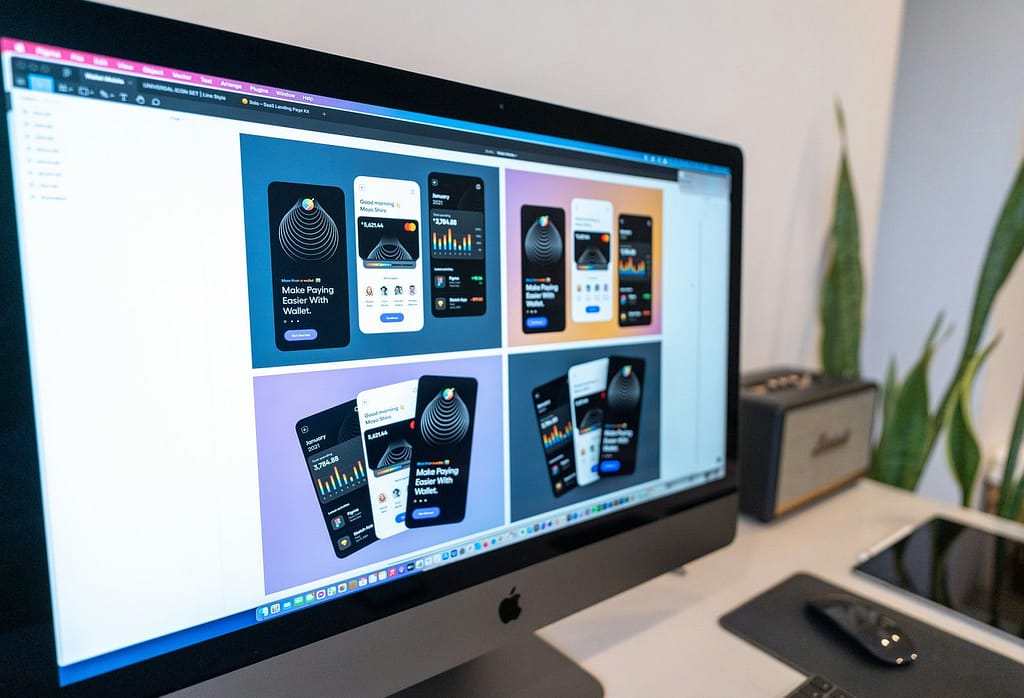Where first impressions matter the most, the design and functionality of landing pages play a pivotal role in converting visitors into customers and leads!
A landing page serves as the gateway to your product or service, and mastering the art of creating high-converting landing pages is essential for online success.
At DevTable we are proud to bring you high quality content that helps you grow your business and boost your online presence. Want to grow your brand and get more leads? Click here to book a free consultation!
I. Know the purpose of a Landing Page
A. What is a Landing Page?
So what is a landing page? Well landing pages are standalone web pages created with a specific purpose – to convert visitors into leads or customers.
Unlike other web pages, they focus on a single call-to-action (CTA) and are designed to guide visitors toward that action.
B. Importance of High Converting Landing Pages
A well-optimized landing page can significantly increase conversion rates, turning casual visitors into engaged customers.
The art lies in understanding the various elements that contribute to a landing page’s effectiveness.
II. Understand Your Audience

A. Knowing Your Target Audience
Before diving into the design process, it’s crucial to have a deep understanding of your target audience. What are their needs, preferences, and pain points?
Tailoring your landing page to address these factors ensures a more personalized and effective approach.
B. Tailoring Content to Audience Needs
Once you’ve identified your audience, create content that resonates with them.
Use language and visuals that connect on a personal level, making visitors feel that your product or service is the solution they’ve been searching for.
III. Captivating Headlines
A. Crafting Compelling Headlines
The headline is the first thing visitors notice. Craft headlines that are not only attention-grabbing but also clear and relevant.
Ambiguous or confusing headlines can lead to a high bounce rate, defeating the purpose of your landing page.
B. Importance of Clarity and Relevance
Ensure that your headline clearly communicates the value proposition of your offer.
Visitors should instantly understand what the page is about and why they should take the desired action.
IV. You Need High Quality Visual Elements!

Visual elements such as high quality images and videos can significantly enhance the appeal of your landing page. Use high-quality visuals that align with your brand and help tell a compelling story.
Searching and or creating high quality graphics that mesh well with your site can be a tough and time consuming task, the best course of action is to hire an experienced graphic designer to create and provide these visuals and graphics.
Maintain a consistent visual design throughout the page.
Inconsistencies can create confusion and distract visitors from the primary CTA.
A visually cohesive landing page fosters a sense of professionalism and trust.
Finding the right graphic designer can be difficult: click here to find the top graphic designer in your area
V. Clear Call-to-Action (CTA)
A. Importance of a Strong CTA
The CTA is the heart of your landing page. Make it stand out by using contrasting colors and placing it prominently on the page.
The language should be persuasive and guide visitors toward the desired action.
B. Placement and Design Considerations
Experiment with the placement of your CTA button. Above the fold is a common practice, but depending on the content, placing it strategically throughout the page can be effective.
Test different designs to see what resonates best with your audience.
We mean it, Make sure it is easy to read and understand! Sometimes you just need to tell your user exactly what you want them to do!
VI. Persuasive Copywriting
A. Crafting Convincing Copy
The written content on your landing page and website should be concise, compelling, and persuasive.
Clearly articulate the benefits of your product or service and address any potential objections visitors may have.
B. Addressing Pain Points and Solutions
Identify the pain points your audience experiences and highlight how your offering provides solutions.
Effective copywriting directly speaks to the visitor’s needs and creates a connection.
VII. Mobile Responsiveness

A. The Significance of Mobile Optimization
With the increasing use of smartphones, optimizing your landing page for mobile devices is non-negotiable.
Ensure that the page is responsive and provides a seamless experience across various screen sizes.
Is you website optimized for mobile? Check out our Responsive Website Design and Development Services
B. Best Practices for Mobile Landing Pages
Condense content, optimize images, and simplify navigation for mobile users.
A positive mobile experience contributes to overall user satisfaction and conversion rates.
VIII. Loading Speed Optimization

A. Impact of Page Loading Speed
Page loading speed is a critical factor in user experience.
Slow-loading pages can lead to high bounce rates.
So what can you do? Optimize images, use browser caching, and employ content delivery networks (CDNs) to enhance page speed.
B. Techniques for Faster Loading
Compress images, minimize server requests, and leverage browser caching to improve loading times.
A fast-loading page not only improves user experience but also positively influences search engine rankings.
Is your website loading slow? Click here to get a free website audit and get our help to boost your website speed!
IX. Social Proof
A. Building Trust with Testimonials
Integrate customer testimonials and reviews to build trust.
Real-life experiences from satisfied customers serve as powerful endorsements for your product or service.
B. Showcasing User Success Stories
If possible, showcase user success stories through case studies or before-and-after scenarios. Demonstrating the positive impact of your offering adds credibility and persuades potential customers.
X. A/B Testing
A. The Importance of Testing
Continuous improvement is key to high-converting landing pages.
Implement A/B testing to compare different elements, such as headlines, visuals, and CTAs, to determine what resonates best with your audience.
B. Implementing A/B Testing for Continuous Improvement
Regularly conduct A/B tests and analyze the results.
Use the data to make informed decisions and refine your landing page elements for ongoing optimization.
XI. Analytics and Data
A. Utilizing Analytics Tools

Leverage analytics tools like Google Analytics to track user behavior on your landing page.
Understand where visitors are dropping off and use this information to make informed adjustments.
B. Interpreting Data for Optimization
Data-driven decisions are crucial for success.
Interpret analytics data to identify patterns and trends, allowing you to optimize your landing page for better performance.
XII. Trust Signals
A. Incorporating Trust Badges
Trust badges, security certifications, and affiliations contribute to the credibility of your landing page. Assure visitors that their information is secure, building trust and confidence.
B. Building Credibility
Share relevant credentials, awards, or partnerships that highlight the reliability of your brand.
Establishing credibility is essential in convincing visitors to take the desired action.
XIII. Personalization
A. Tailoring Landing Pages for Individuals
Personalization goes beyond addressing the audience as a whole.
Tailor landing pages based on user behavior, demographics, or preferences to create a more personalized experience.
B. Dynamic Content for Enhanced Personalization
Consider incorporating dynamic content that adapts based on the visitor’s profile or interactions.
Personalized experiences resonate more strongly with users and increase the likelihood of conversion.
XIV. Optimizing for SEO
A. Importance of Search Engine Visibility
Optimizing for search engines is crucial for attracting organic traffic.
Conduct keyword research and incorporate relevant keywords naturally into your content.

B. Implementing SEO Best Practices
Optimize meta tags, headers, and image alt text.
A well-optimized landing page enhances visibility in search engine results, increasing the chances of attracting qualified leads.
XV. Monitoring and Iteration
A. Continuous Monitoring of Performance
The work doesn’t end after launching a landing page.
Continuously monitor its performance to identify areas for improvement and adaptation to changing market dynamics.
B. Iterative Improvements for Long-Term Success
Apply the insights gained from monitoring to make iterative improvements.
A commitment to ongoing refinement ensures that your landing pages stay relevant and effective in the long run.
Conclusion
In conclusion, the art of creating high-converting landing pages requires a thoughtful combination of design, content, and optimization. Understanding your audience, crafting compelling headlines, utilizing engaging visuals, and incorporating persuasive copywriting are all essential elements. Regular testing, analytics interpretation, and continuous improvement contribute to sustained success in the highly competitive online landscape.
Contact us today to get landing pages that work for you and your business
FAQs
Regular updates are recommended, especially after implementing A/B test results. Aim for at least quarterly reviews to ensure relevance.
The length should be sufficient to convey necessary information but concise enough to maintain visitor interest. Aim for around 500 to 1000 words.
It’s advisable to create campaign-specific landing pages to tailor content and messaging to the unique aspects of each campaign.
Utilize analytics tools like Google Analytics to track metrics such as conversion rates, bounce rates, and user behavior.
Absolutely. With a significant portion of internet users on mobile devices, optimizing for mobile ensures a seamless user experience and maximizes conversion opportunities.
